Spectacular Monteriggioni, north of Siena, is a medieval stronghold, encircled by well-preserved stone walls and fourteen towers. Like Montepulciano, this small hilltop town is emblematic of the Tuscan landscape. Often dubbed `the gateway to the Middle Ages,’ the walled outpost of Monteriggioni is the quintessential medieval town, bristling with fortifications. The hilltop town was built by the Sienese in the thirteenth century to protect their front line from their eternal rivals, the Florentines. Monteriggioni also grew wealthy as a strategic stop along the Via Francigena pilgrimage route. In terms of size and modern-day status, Monteriggioni feels more like a forgotten backwater. It is only when the popular summer medieval festival comes to town that Monteriggioni recalls its past importance, complete with feasting, falconry, jousting and battle re-enactments. Beyond the theatricality of the setting, there are few significant sights but a visit is worthwhile for the magical mood and monumentality alone.
Monteriggioni
-
-
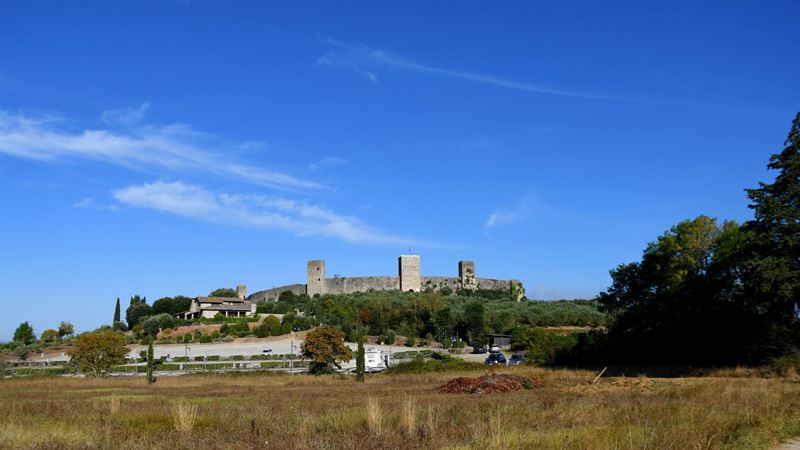
Top Ten Things to do
Monteriggioni lies in the heart of Tuscany, convenient for a day trip to medieval Siena or even Florence. Monteriggioni can also be a stepping-stone to the countryside, especially to the Chianti, including gentle meandering through wine country around Castellina in Chianti and Radda in Chianti. If enthused by Monteriggioni’s medieval towers, visit celebrated San Gimignano or Etruscan Volterra for more medieval townscapes and towers. For shopping for the finest crystal, visit medieval Colle di Val d’Elsa. Other activities include walking or cycling to neighbouring Montagnola or exploring a stretch of the Via Francigena pilgrimage route.
-
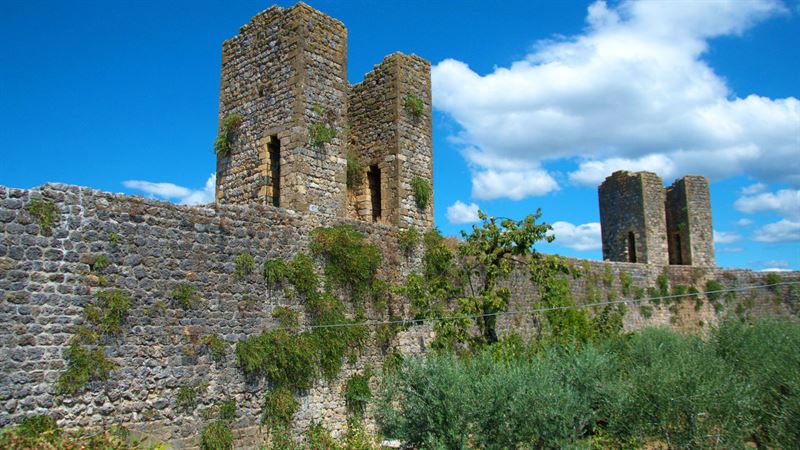
1. Medieval mooch around Monteriggioni
Monteriggioni, with its formidable ring of walls and towers, dominates the surrounding hills. Monteriggioni was built in 1213 to guard the northern borders of Sienese territory. In 1554 a major betrayal cost the town its freedom and it fell into Florentine hands, presaging the final loss of the Republic of Siena to Florence in 1555. Fortifications like this played an important role in medieval Tuscany. These walled hilltop towns, often known as borghi, are emblematic of the Tuscan cityscape. Like Montepulciano and Buonconvento, Monteriggioni provides proof that preserving walls helps preserve a distinct identity.
The slopes leading upto the medieval borgo are swathed in olive trees, vineyards and even poppies, a bucolic view changing with the seasons. Porta Franca, the Siena-facing main gateway, guards the entrance to the borgo and once had a fearsome drawbridge. Instead, the Porta di Ponte arched gateway faces Florence and displays a quotation by Dante about Monteriggioni’s mighty walls. Monteriggioni in Arme, the Museum of Arms, is the place to put yourself in the shoes of a legendary knight of old. It’s not surprising that the town inspired the popular Assassin’s Creed video game. The museum displays reproductions of medieval and Renaissance armour and weaponry and also introduces you to siege engines and siege techniques. Walking the battlements gives you a true sense of what it must have been like to be a medieval knight or a night-watchman doing the rounds. Once on the ramparts, you can take in expansive views of the poppy-strewn countryside stretching towards the Chianti region and the Val d’Elsa. The ramparts are currently being restored but can still be partially explored. This is a place for what Italians call il dolce far niente, the sweet art of doing nothing at all. Before heading off to lunch, visit the stone-arched parish church, typical of the medieval air that swathes Monteriggioni. Even if wine may be on your mind, look out for signs of water. The abundance of wells and fountains in the tiny town squares reminds us of the importance of water during sieges.
Address: Monteriggioni tourist office
Piazza Roma 23
53035
Monteriggioni
Tel: 0577 304834
Web: www.monteriggioniturismo.it -
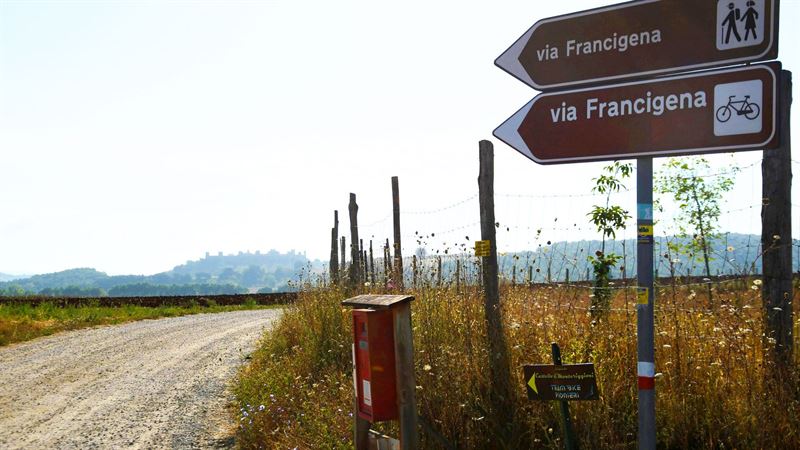
2. Pilgrimage route to the Romanesque abbey of Abbadia a Isola
The Romanesque abbey of Abbadia a Isola lies only 4 km from Monteriggioni and makes an appealing walk along a stretch of the Via Francigena pilgrimage route, particularly when surrounded by fields of sunflowers in full bloom. The Benedictine abbey of S. Salvatore all’Isola dates back to 1001, with the site chosen for its strategic position controlling the Via Francigena. It was once more remote: the name (`isola’ means island) reflects the fact that the abbey was surrounded by swampland until the 18th century. For centuries, the abbey acted as a pilgrims’ hospice, providing rest, hospitality and medical care to pilgrims on their way to Rome. The monastery only started to decline in the mid-15th century but still retains its ancient function, with a modern hostel playing host to passing pilgrims. The abbey is centred on the Romanesque church of San Salvatore, complete with its three naves and three apses. Inside the church are precious works of art, including the beautiful panel-painting over the main altar, created in the fifteenth century by the Sienese artist Sano di Pietro. Although ruined, the rest of the abbey is still atmospheric, including the quadrangle of the ancient cloisters and the remains of the bell-tower. Part of the site was swallowed up by farm-building but is currently being restored, even if much is done, including the creation of exhibition rooms, with a Via Francigena centre to come. The fortified abbey also embraces what is today a small hamlet, with lovely views on the walk back, towards walled Monteriggioni.
Address: Monteriggioni tourist office
Piazza Roma 23
53035
Monteriggioni
Tel: 0577 304834
Web: www.monteriggioniturismo.it -
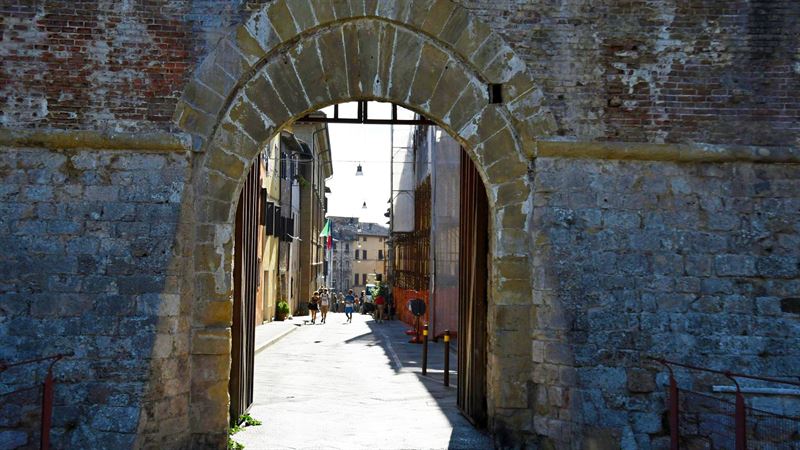
3. Colle di Val d’Elsa - `city of crystal’
Consider a visit to Colle di Val d’Elsa, an underrated medieval town 11 km north of Monteriggioni. Admire the moated bastions and medieval gateway that lead to the lovely upper town, with its curious tunnelled alleys. Then discover why Colle is dubbed `crystal city’ (città del cristallo). The town is home to Italy’s crystal industry and can cope with any design, from classic to cutting-edge, and offers intriguing insights into local history. Colle’s glassmaking industry supposedly dates back to 1331, when the town was an independent, self-governing entity. The real push came in the 17th-century, when the leading Usimbardi family re-introduced glass production in a systematic way. The town has never looked back. The glassmaking industry gradually switched to the production lead-glass crystal and, by the 19th century, Colle was dubbed the Bohemia of Italy for its crystal-making expertise. In 1820 the French glassmaker Francesco Mathis opened a crystal factory in the lower part of the village. Today, Colle di Val d’Elsa accounts for 95 percent of Italian crystal production and 15 percent of production worldwide. The first Sunday of every month you can see how glass is produced in an open-air demonstration. You might see glassmakers engraving wine goblets with intricate designs or see glass sculptures being moulded into the shape of a swan, snail, horse or fish, all made out of molten glass. The glass-making demonstration often takes place in the historical centre at via della Misericordia, close to the Cathedral, at around 3pm, but check with the tourist office.
The Crystal Glass Museum, set in the lower town, displays a collection of handmade crystal glass from medieval times to the 20th-century and also explains the manufacturing techniques. The museum is housed underground, underneath a former glass factory, where the furnaces were once sited. Known as the Museo del Cristallo, the museum is closed for refurbishment until early 2019 but in the meantime some of the collection is still on display elsewhere in town. See some of the star exhibits in the Museo San Pietro (on 102 via Gracco del Secco 102) and in the Palazzo dei Priori (33 via del Castello). After learning a bit about the story of crystal, call into local shops to buy some glassware of your own.
Address: Museo del Cristallo
Via dei Fossi 8A
Colle di Val d'Elsa
Tel: 0577 924135
Web: www.museodelcristallo.it -
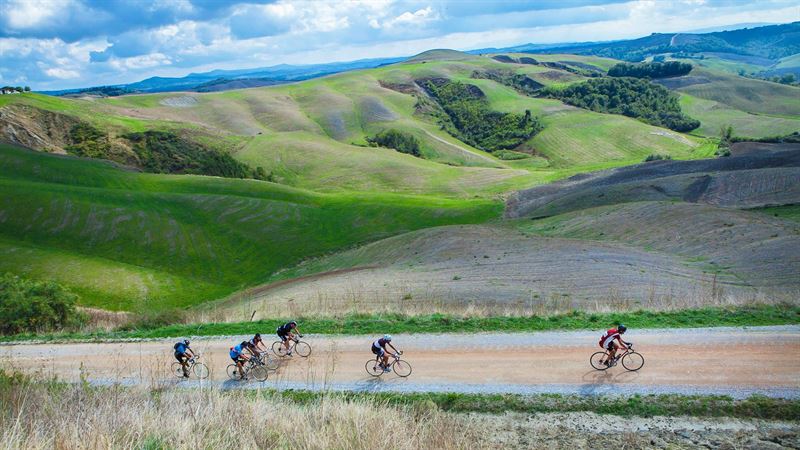
4. Cycle rides and hikes around Monteriggioni
Monteriggioni is hiking and cycling country and works for both experienced cyclists and beginners. Consider hiring a bike and setting off on an exploration, with shorter routes connecting Monteriggioni and Strove, beyond Abbadia a Isola, or Colle di Val d’Elsa, and longer routes running all the way to San Gimignano or Siena. The typical Tuscan scenery spans ruined castles, medieval chapels and quaint hamlets, known as borghi. En route, expect vineyards, cypress-studded hills, sun-drenched olive groves and fields of poppies or summery sunflowers. The cycling route connecting Monteriggioni and Colle di Val d’Elsa is worth doing. It crosses the Val d’Elsa, winding along a mixture of country lanes and secondary roads past vineyards and olive groves, taking in the Romanesque abbey of Abbadia Isola. Hikers can cover short stretches of the Via Francigena pilgrimage route, including a short walk from Monteriggioni to Abbadia Isola and then continuing on to Strove, just south, to see another sleepy Romanesque church. Even if many of these routes are covered on the official Monteriggioni website, it’s best to visit the helpful tourist office in person for maps and advice to suit your level and needs.
Address: Monteriggioni tourist office
Piazza Roma 23
53035
Monteriggioni
Tel: 0577 304834
Web: www.monteriggioniturismo.it -
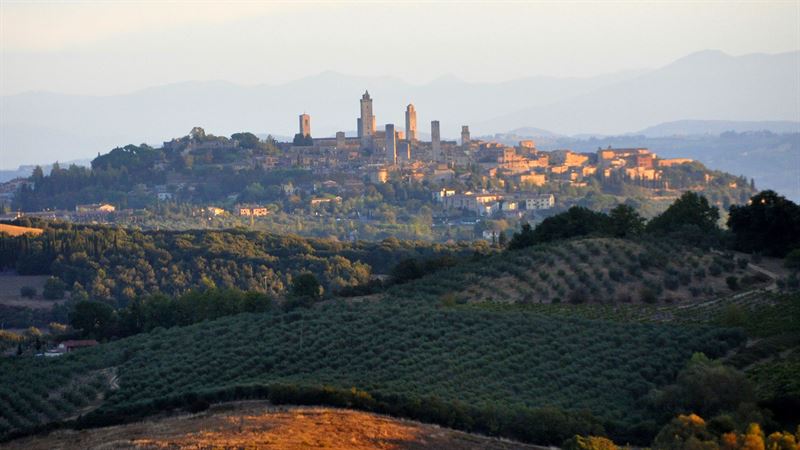
5. San Gimignano – medieval Manhattan
San Gimignano is only 26 km north-west of Monteriggioni so makes a worthwhile trip to see one of the medieval wonders of Tuscany. Given its spectacular setting, San Gimignano is one of the most touristy towns in Tuscany but manages to rise above the masses. With its moody medieval towers and walls, the town is one of the symbols of Tuscany. Building a lofty tower-house represented one-upmanship, medieval-style. The tower-studded skyline is one of the most spectacular sights in Tuscany. In its heyday, the city had a total of 72 towers, only 14 of which remain. Tower-houses were castle-residences serving as both warehouses and fortresses. A plague in 1348 wiped out much of the local population and the town slumbered as a backwater for centuries. The result is a medieval time capsule, even if the town is far from slumbering today. Its over-popularity and sometimes inflated prices are the only downsides but shouldn’t deter you from joining the throng.
The towers alone make a visit to this medieval time capsule worthwhile. Make time for Torre Campatelli, a true tower-house you can actually visit. This intriguing tower-house was home to the last resident of an illustrious Florentine clan. Apart from the medieval cityscape, the main sites are churches and public buildings. The best are congregated around the triangular Piazza della Cisterna and Piazza del Duomo. Here, the Palazzo Comunale is the forbidding fortress at the centre of city life since the days when Dante came on an ambassadorial visit from Florence.
Take a short walk along the city walls to la Rocca, the 14th-century fortress, before leaving town. This semi-restored fortress enjoys views over terraced gardens and olive groves winding down to the Vernaccia vineyards. The fortress is home to an enoteca, a wine-tasting experience, which traces the history of Vernaccia, the town’s most famous wine. You can even book a Vernaccia master class through the tourist office. If staying for longer, escape the crowds on a rural walk along stretches of the Via Francigena pilgrimage route outside San Gimignano. This is best booked through the tourist office. See our full San Gimignano guide for more.
Address: Museo Vernaccia
La Rocca
Via della Rocca
San Gimignano
Tel: 0577 941267
Web: www.sangimignanomuseovernaccia.com -
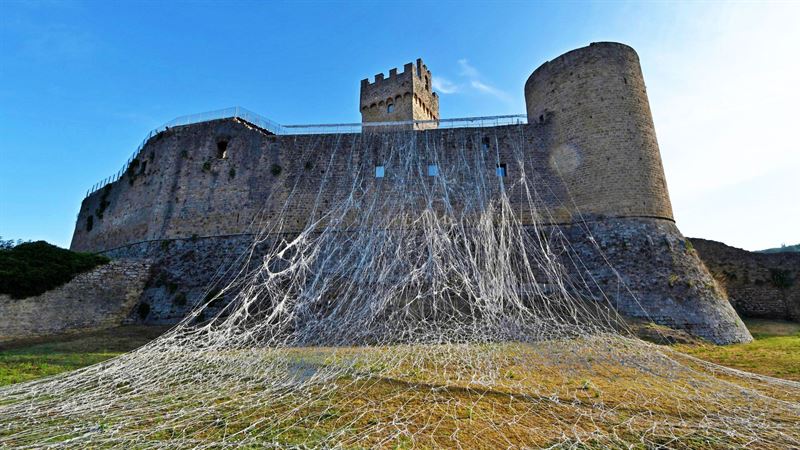
6. La Rocca di Staggia – contemporary art in Crusader castle
La Rocca di Staggia is an impressive fortress midway from Monterrigioni (7 km) and Poggibonsi (8 km). The recently restored Rocca began as a Longobard fortress but gradually became a beacon on the Via Francigena pilgrimage route. In the 14th century it came under Florentine influence and, as a bulwark against the Sienese, was constantly fortified and expanded. The Florentines also created a raised walkway, still partly walkable, that linked the castle and the village of Staggia. Today, thanks to a major restoration, the castle walls are virtually intact, including two gateways and sections of the battlements once patrolled by night-watchmen. The fortress, which was partly remodelled using Brunelleschi’s designs, was largely abandoned in modern times until it re-opened in 2007. First impressions reveal a squared-off Longobard structure rising up within a warrior-like keep. The interior is very different, contrasting contemporary art installations with the ancient walls. You can only visit the castle on a guided tour, which combines the castle history with background to the bizarre art installations. Highlights of the tour include the views from the night-watchmen’s walk and the esoteric history of this medieval stronghold, with its curious mix of east and west. As well as offering avant-garde temporary art exhibitions, the foundation in charge of the castle have opened it up to events and festivals and also run local trails. The fortress is particularly impressive at night, when seen lit up from afar.
Address: Via dell'Ospedale 2
53036
Staggia Senese
Poggibonsi
Tel: +39 366 4792092
Web: www.laroccadistaggia.it -
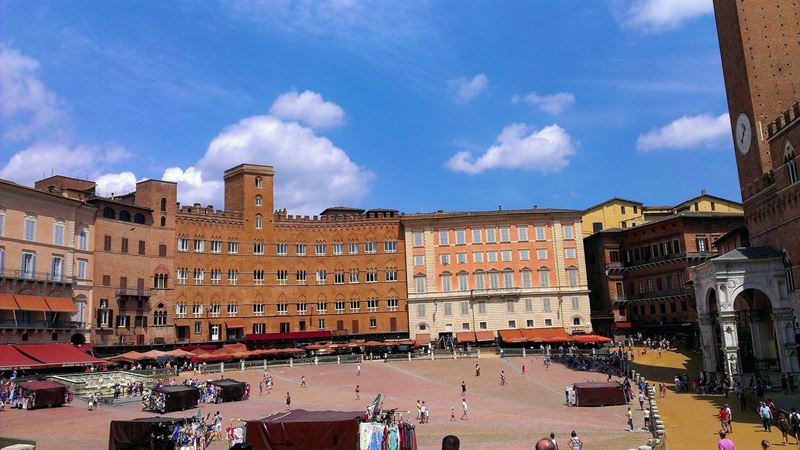
7. Day trip to Siena
Siena lies 15 km south of Monteriggioni and makes a magical day trip. As a Gothic city built on a human scale, Siena is effortlessly civilised and at ease with itself. All roads lead to Il Campo, the beguiling, shell-like central square, shaped like an amphitheatre. Sit at a terraced café on the sloping side of the square and spot the division of the paved surface into nine segments, recording the wise Council of Nine who governed Siena from the mid-13th century to the early 14th. Consider climbing the slender Torre del Mangia, with sultry views over a pink piazza and Siena’s rooftops, even if the views from the Cathedral rooftops are even better.
After an early lunch, a leisurely stroll leads to the Duomo, Siena’s pinnacled Gothic cathedral. The facade is a riot of green, pink and white marble, like a glorious iced cake. Siena Cathedral and the Cathedral Museum should be seen as one entity as they share several spaces. The Museum displays Pisano’s orig¬i¬nal statues for the façade along with Siena’s best-loved work, Duccio’s Maestà, the Virgin Enthroned. For many visitors, equally impressive is the rooftop walk, known as the Panorama from the Unfinished Façade. These are arguably the finest views of Siena. Facing the cathedral is the Spedale di Santa Maria della Scala, the most extraordinary building in Siena. It began as a hospital a thousand years ago and continued as one until it was reborn as a magnificent museum in recent years. In medieval times, it was always far more than a hospital. The art-studded complex embraces a former pilgrims’ hostel, an orphanage, frescoed churches and granaries.
Don’t let Siena’s art-studded museums blind you to the beauty of the backstreets. Here, the city history unfurls like a medieval banner. Walkable Siena has well-preserved walls and inviting gateways. Wind through a tangle of medieval streets and stumble across secret courtyards, fountains and surprisingly rural views. Check our Siena guide to see what appeals most.
Address: Siena tourist office
Spedale di Santa Maria della Scala
Piazza Duomo
Tel: 0577 280551
Web: www.terresiena.it -
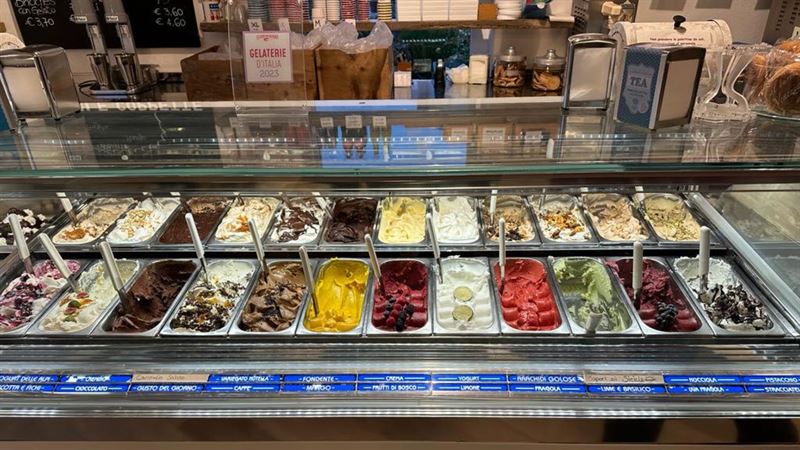
8. Taste of Chianti country
Castellina in Chianti, a gateway to this celebrated wine country, lies 19 km north-east of Monteriggioni. In town, explore the Archaeological Museum to see finds from Etruscan tombs, including an amphora depicting drinking and feasting, showing that wine was a sign of status, drunk at rituals and ceremonies. Even though the tombs were built nearly 3,000 years ago, the creators feel very much like ourselves. Climb to the tower-top walkway to enjoy sweeping views over the Chianti mountains, San Gimignano and the Val d’Elsa. Wander down via delle Volte, a quaint stone-vaulted street built into the side of the hill.
Consider your first wine-tasting at an enoteca as Castellina is awash with Chianti Classico. The trademark on bottles of Chianti Classico is the Black Rooster (or Black Cockerel), the historic symbol of the Chianti Military League. In the late 13th century, Castellina was the first site of the Chianti League, a group of three Florentine feudal castles. Call into L’Antica Trattoria alla Torre for lunch. Set on the main square, this old-fashioned inn serves Tuscan treats on a summery terrace. Tuck into the Florentine T-bone steak, grilled meats and Pecorino cheeses, all washed down with Chianti Classico wines, of course.
After lunch, devour delicious ice cream at Gelateria Castellina, known for its experimental ices. The flavours range from ricotta and fig to chilli and chocolate or lemon and kiwi fruit. There’s also the owner’s favourite creation, cantuccini and Vin Santo: almond biscuits with sweet Tuscan wine. There’s no escaping wine in the Chianti. Before leaving, stock up on Tuscan foodstuffs, including cheeses, biscuits and cured meats. For tips on Chianti culture, wine-tasting, dining or shopping suggestions, see our guide to Castellina in Chianti but also check our general Chianti guide. You could continue exploring Chianti wine country in Radda in Chianti, just east of Castellina.
Address: Gelateria Castellina,
Via IV Novembre 47
53011
Castellina in Chianti
Tel: 0577 741337
Web: www.gelateriadicastellina.it/ -
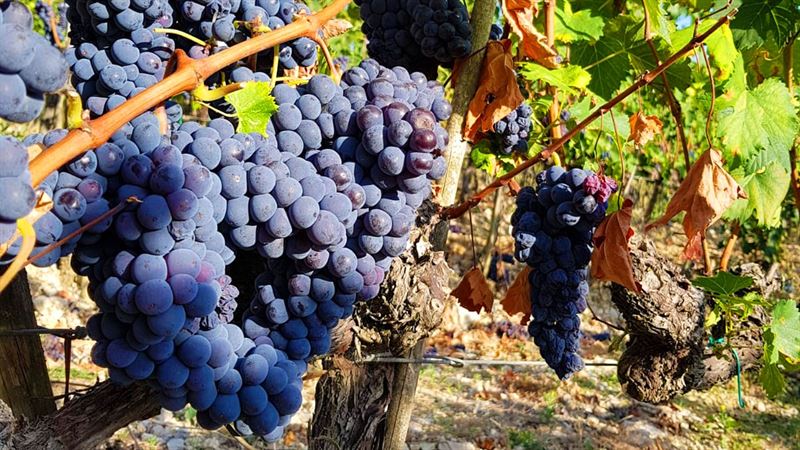
9. Radda in Chianti for a wine class, tasting and lunch
Radda in Chianti, just east of Castellina in Chianti, is a lovely way to extend your Chianti day trip. Radda once served as the capital of the Chianti and is still the place for sensing the Chianti spirit – and for getting to grips with the region’s lifeblood. Stroll round this glorified village with the spirit of a town, framed by its defensive walls. After wandering along the cobblestoned alleys fanning out from the main square, head to Casa Chianti Classico for an illuminating wine induction tour.
Casa Chianti Classico is housed in an 18th-century Franciscan monastery in the upper part of town. Itself attached to a medieval church, this sacred complex is now a shrine to wine, with a Wine Museum on the first floor. Sign up to a 90-minute wine class or restrict yourself to learning all about Chianti before facing an entertaining multimedia wine quiz. After doing a wine-tasting and dutifully going through your tasting notes, you deserve lunch in the Enoteca. Even better, it features a charming terrace surveying the Chianti vineyards.
As a major wine centre, Radda has been quietly prosperous since the 16th century when it was already exporting wine to England. Later, in 1716, Cosimo III, Grand Duke of Tuscany, officially delimited the production zone of Chianti wine. Along with Radda, the main centres in Chianti Classico remain Greve, Panzano, Castellina, Gaiole and Fonterutoli. The boundaries and strict rules still apply, even if the responsibility for enforcing them has passed to the Chianti Wine Consortium. The Consortium was established in 1927 by a group of wine producers in the Provinces of Florence, Siena, Arezzo and Pistoia. Easily accessible off the scenic route SS222, the grandest, castle-like estates have often been run by the same families since medieval times, as is the case with the aristocratic Antinori, Frescobaldi, Mazzei and Ricasoli dynasties. Tuscany’s aristocrats are still over-represented in the wine business, including in the Chianti Classico Wine Consortium. On the board are a clutch of Tuscan nobles, ancient wine dynasties who have moved with the times. The great names include Marquess Lodovico Antinori, Count Lorenzo Guicciardini, Prince Emmanuele Corsini and Count Guido Chigi-Saracini.
Even so, the wine is bigger than the individual families, no matter how glorious their pedigree. The wine’s `soul’ is Sangiovese. The rules for Chianti Classico wine allow for a minimum ratio of eighty percent of Sangiovese, the typical red regional variety. A maximum of twenty percent of other local red grapes can be added to the blend. These varietals include native grapes such as Canaiolo and Colorino, along with `international’ Cabernet Sauvignon and Merlot, all permitted in this Chianti Classico production zone. In essence, Chianti Classico is made from Sangiovese grapes, or a Sangiovese blend, and aged for 14 months in French oak barrels followed by at least seven months in the bottle, or two years for a Riserva. If all this wine talk is giving you an appetite, see our Radda guide for full dining options.
Address: Museo del Vino (Wine Museum)
Monastero Santa Maria al Prato
Circonvallazione Santa Maria al Prato 18
53017
Radda in Chianti
Tel: 0577 738187
Web: www.chianticlassico.com -
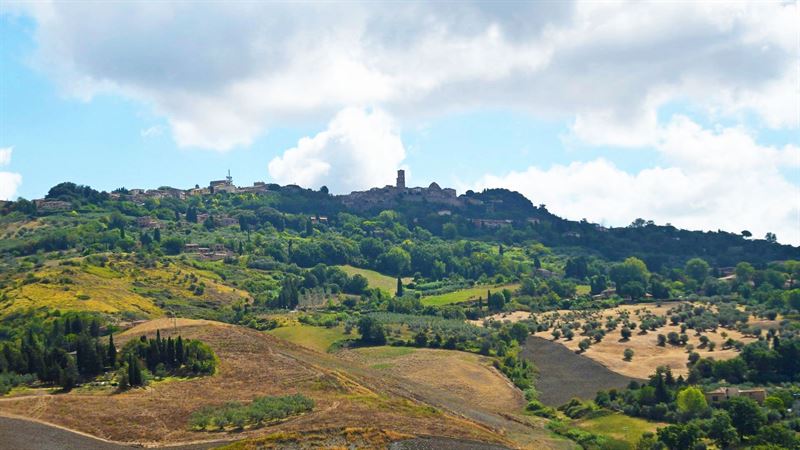
10. Bewitching Volterra
Volterra lies 40 km west of Monteriggioni and represents a magical outing. Volterra is beguiling, less touristy than San Gimignano, Cortona or Pienza but arguably just as compelling. Perched on a majestic, windswept ridge overlooking the Sienese hills, Volterra commands its setting and remains the most Etruscan of Tuscan cities. The Porta all’Arco, the Arched Gate, is the best-preserved Etruscan gateway in Italy, dating from the 4th century BC. Partially remodelled by the Romans, the gate still rests on massive Etruscan bases and is the only surviving part of the Etruscan walls. Volterra displays some of the best Etruscan art outside Rome, with the finest treasures in the Museo Etrusco Guarnacci. Founded in 1761, this is one of the oldest public museums in Europe and is easily the city’s finest museum. The funerary urns and alabaster sarcophagi run the gamut of Etruscan demonology and Greek mythology, featuring sea monsters, Greek gods, beaked griffins and sirens. Any walk through Volterra reveals Roman remains, the Etruscan city the Romans adapted to their tastes. Etruscan Velathri became Volterrae, an important Roman municipality when Rome annexed Etruria in 351 BC.
Beyond Etruscan Volterra is the visual magnificence of the medieval city. Piazza dei Priori, the town’s set-piece square, is proof of Volterra’s rich medieval heritage, with its cluster of noble palaces. The square is dominated by the lofty Palazzo dei Priori (1208), the oldest town hall in Tuscany and supposedly the model for Florence’s Palazzo Vecchio. To the south of Piazza dei Priori is Piazza San Giovanni, the religious centre of Volterra. Crowning the square is the 12th-century Duomo, with its Pisan Romanesque façade. Renaissance buildings blend in surprisingly gracefully with the medieval Volterran houses. Palazzo Incontri-Viti is an impressive mansion that also feels like a private home. It began as the home of a discerning alabaster merchant and his heirs are still in residence. Each salon is grander than the next, adorned with art, porcelain and alabaster, a reminder that the palace once belonged to one of Volterra’s richest citizens. After exploring the patrician palaces, retreat to Le Cantine del Palazzo, the Etruscan-Roman cellars below Palazzo Incontri-Viti, for a drink or a meal in a cavern-like setting with a Roman cistern as decoration.
No visit to Volterra is complete without seeing an alabaster-carving workshop. As everything in Volterra, even alabaster-carving is an Etruscan legacy. It is one of the many gifts the Etruscans have passed onto their descendants in this most Etruscan of cities. The ancient craftsmen made great use of alabaster from the 5th century BC onwards, primarily for their beautifully sculpted funerary urns. In the local museums and workshops you’ll come across bowls, urns, medallions, religious artefacts, candleholders, lamps, vases and Neoclassical sculpture. classic Tuscan cuisine. Ender your stay in a vaulted Volterra inn. Tuck into zuppa volterrana, a thick vegetable and bread soup, or trippa alla volterrana (tripe cooked with tomato, sausage and herbs). Other hearty dishes include pappardelle di lepre (pasta ribbons in hare sauce) or the same pasta with wild boar (cinghiale). For more on the city, see our full Volterra guide.
Address: Volterra tourist office
Tel: 0588 87257
Web: www.volterratur.it -
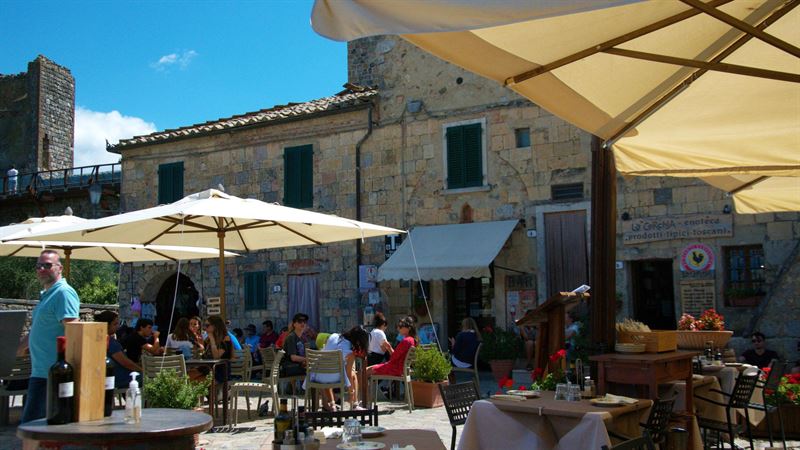
Eating & Drinking
Monteriggioni is made for hearty eating, helped by its closeness to both the Chianti and San Gimignano. As a result, the area abounds in homely inns, even if only a few are within the walls, and the rest dotted around neighbouring hamlets. For fine dining or greater sophistication, be prepared to drive just north to Colle di Val d’Elsa. The Monteriggioni borgo is best seen first thing in the morning, when you can enjoy a coffee on the main square before the coach parties arrive. The local cooking is a familiar interpretation of classic Tuscan cooking, with borrowings from nearby Siena and the Chianti. Look out for ribollita, a thick bean soup, or pasta dishes including such stalwarts as pappardelle di lepre (pasta ribbons in hare sauce) or the same pasta with wild boar (cinghiale). As for wine, the Chianti Colli Senesi is the biggest Chianti zone, embracing this area, San Gimignano, Colle di Val d'Elsa and Siena. This fresh young red wine goes well with cured meats, such as cinta senese, as well as with bruschetta, soups, mushroom sauces, game, grilled and roast meats, plus most cheeses and cured meats.
-
Osteria Antico Travaglio
Set on the charming main square, in a converted blacksmith’s forge, this mellow, multifaceted spot acts as an inn, bar and ice cream parlour. Come for an aperitivo, bruschetta and cured meats or tuck into a Tuscan feast, ranging from pappardelle or Sienese-style pici pasta with mushrooms or game, followed by grilled meats or a T-bone steak. Locals swear by the delicious ice creams in the gelateria.
Address: Piazza Roma 6a
53035
Monteriggioni
Tel: 0577 304718
Web: www.anticotravaglio-monteriggioni.com -
Bar dell’Orso
Just outside Monteriggioni, this affordable bar and inn serves Tuscan staples, such as stews and home-made pasta dishes but can also do a quick stuffed panino or an afternoon snack of cured meats.
Address: Via Cassia Nord 23
53035
La Colonna di Monteriggioni
Tel: 0577 305074 -
Ristorante Arnolfo
Set in an airy mansion, this pricey two-Michelin-starred restaurant is made for special occasions. Gorgeously presented Tuscan-inspired dishes are interpreted in creative, gourmet-style fashion. Typical dishes include: quail’s egg in meat broth; saffron risotto with country herbs; cinta senese suckling pig served on a bed of lentils and prune; and cappelletti pasta in a rich Chianti sauce. Expect creative menus (including vegetarian options) from chef Gaetano Trovato in a price range varying from €120-€160 without wine.
Address: Via XX Settembre
50
53034
Colle di Val d’Elsa
Tel: 0577 920549
Web: www.arnolfo.com -
Molino al Moro
This romantic, old-world restaurant occupies an old mill just north of town. As well as Tuscan classics, such as cured meats, the inn delivers more sophisticated, lighter, seasonal dishes, all mid-priced. Favourites include the truffle dishes and the home-made ice creams. Equally delicious are the following dishes: Parmesan flan with truffle cream sauce; risotto made with a pungent Pecorino di Fossa cheese and Chianti wine; and the tagliatelle pasta with artichokes and a saffron sauce. The presentation is as elegant and enticing as the vaulted stone setting, with views through glass of the running river below the mill.
Address: Via della Ruota 2
53034
Colle di Val d'Elsa
Tel: 0577 920862
Web: www.molinoilmoro.com/ -
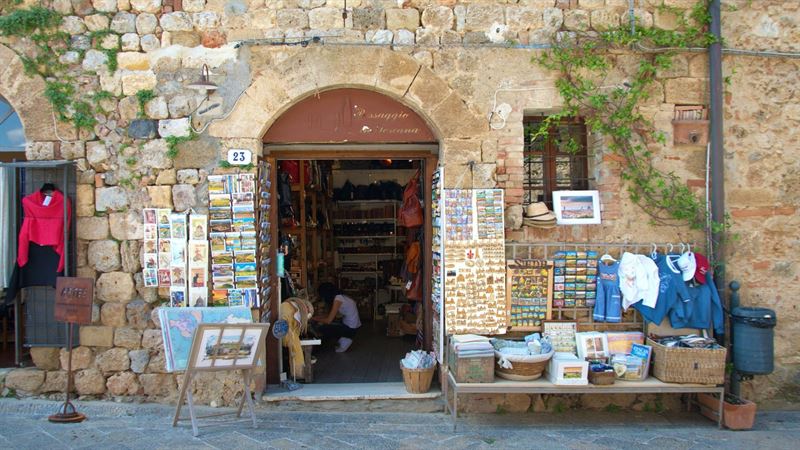
Shopping
Monteriggioni focuses on arts and crafts which, although touristy, are mostly genuinely hand-made so worth investigating. Tucked into medieval lanes are tiny boutiques and workshops where you can watch craftsmen at work, including operating hand-looms. Highlights include hand-crafted knitwear, linen that can be personalised to your taste, jewellery made from semi-precious stones, and hand-painted pottery, with scenes inspired by local landscapes.
Monteriggioni welcomes a farmers’ market, il Mercatale di Monteriggioni, on the first Saturday of the month. In local wine and food shops buy Chianti Colli Senesi wine, along with typical pastries, biscuits and cakes (see Eating & Drinking for more. Also come for the popular summer medieval festival in July for a medieval-themed market, complete with feasting and folklore. Check the dates and programme with Monteriggioni tourist office (Piazza Roma 23, 53035 Monteriggioni. T: 0577 304834 & www.monteriggioniturismo.it plus www.monteriggionimedievale.com).
Beyond Monteriggioni, Siena offers the widest range of shopping options but neighbouring Colle di Val d’Elsa works wonderfully for an array of world-class crystal and glassware. -
Artes
Set within the walled town, Artes is all about knitting and weaving, including the use of hand-looms. Come for hand-made knitwear or loom-woven items, ranging from scarves and shawls to cotton or linen sweaters, fabric handbags or rugs. Much is produced on hand-looms, using traditional methods.
Address: Via I Maggio 21
53035
Monteriggioni
Tel: 0577 300013
Web: www.artesmonteriggioni.com -
GV Decoro Ceramiche
This is artistic, hand-painted pottery, with tasteful scenes inspired by Tuscan traditions or emblematic local landscapes, perhaps featuring olives or cypress trees.
Address: Via Giacomo Matteotti 9
53035
Monteriggioni
Tel: 0577 301111
Web: www.gvdecoroceramiche.com -
La Grotto del Cristallo
This crystal shop sells everything from tableware to crystal chandeliers and hand-crafted jewellery. Champagne flutes, whiskey glasses, picture frames or perfume bottles - this is a treasure-trove for quality crystalware.
Address: Via del Murolungo 20
53034
Colle di Val d'Elsa
Tel: 0577 931879
Web: www.lagrottacrystal.com -
Parking
In Monteriggioni, Castello is the most convenient car park, a paying car park just outside the medieval walled town, and costs from €3 for the hour and then €5 for 24 hours. Alternatively, the Cipressino car park, which is also paying and with similar charges, is 250 metres from the borgo, the walled town.
Most Tuscan towns operate a strict ZTL system, a Limited Traffic Zone. This means that the Centro Storico (historic centre) is essentially closed to traffic, particularly for non-residents. Cars will need to be left outside the walls. Advice on ZTLs: You may see other cars crossing the ZTL boundary (Limited Traffic Zone) and assume you can proceed. Not so. The drivers crossing into the ZTL zone will probably be locals and have residents’ permits. Visitors do not so are liable to fines. Zones are monitored by cameras, so tickets are issued immediately and automatically, as soon as (and each time) the car crosses the ZTL boundary. For more, see http://www.monteriggioniturismo.it/en/useful-information/how-get-here-and-where-park/
-
Getting there & getting around
By car: Monteriggioni is easily reached via the Florence-Siena dual-carriageway, taking the Monteriggioni exit and following signs. The town is also pretty well-situated for day trips, only 14km from Siena and 54km from Florence.
By train: although there’s no direct rail connection from Siena to Monteriggioni, you can get pretty close. The nearest train station is at Castellina Scalo, 3km away from Monteriggioni, on the Empoli-Siena line. Confusingly, the station is officially called Castellina in Chianti-Monteriggioni. There are also services to Florence but you need to change at Empoli.
By bus: Buses link Monteriggioni with Siena, Colle Val d'Elsa, Poggibonsi, San Gimignano and Florence.

























